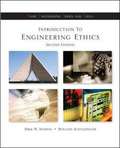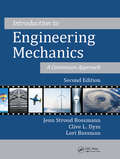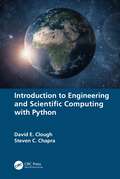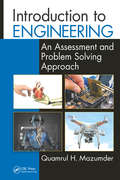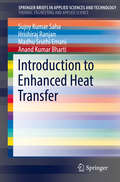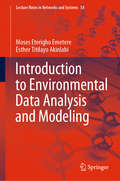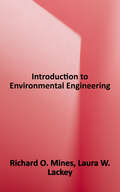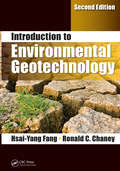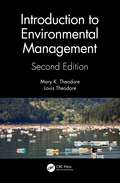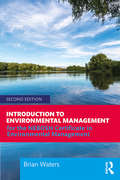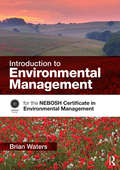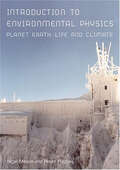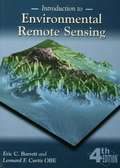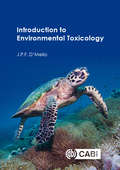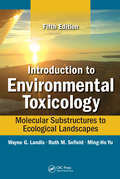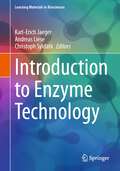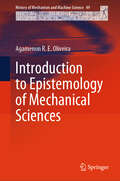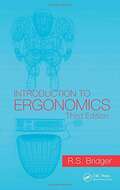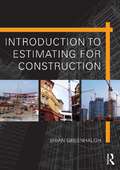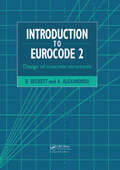- Table View
- List View
Introduction to Engineering Ethics (2nd Edition)
by Mike W. Martin Roland SchinzingerIntroduction to Engineering Ethics provides the background for discussion of the basic issues in engineering ethics. Emphasis is given to the moral problems engineers face in the corporate setting. It places those issues within a philosophical framework, and it seeks to exhibit their social importance and intellectual challenge. The primary goal is to stimulate critical and responsible reflection on moral issues surrounding engineering practice and to provide the conceptual tools necessary for pursuing those issues. Students preparing to function within the engineering profession need to be introduced to the basic issues in engineering ethics.
Introduction to Engineering Materials
by George Murray Charles V. White Wolfgang WeiseDesigned for the general engineering student, Introduction to Engineering Materials, Second Edition focuses on materials basics and provides a solid foundation for the non-materials major to understand the properties and limitations of materials. Easy to read and understand, it teaches the beginning engineer what to look for in a particular
Introduction to Engineering Mechanics: A Continuum Approach, Second Edition
by Clive L. Dym Jenn Stroud Rossmann Lori BassmanIntegrated Mechanics Knowledge Essential for Any EngineerIntroduction to Engineering Mechanics: A Continuum Approach, Second Edition uses continuum mechanics to showcase the connections between engineering structure and design and between solids and fluids and helps readers learn how to predict the effects of forces, stresses, and strains. T
Introduction to Engineering Statistics and Lean Six Sigma: Statistical Quality Control and Design of Experiments and Systems
by Theodore T. AllenThis book provides an accessible one-volume introduction to Lean Six Sigma and statistics in engineering for students and industry practitioners. Lean production has long been regarded as critical to business success in many industries. Over the last ten years, instruction in Six Sigma has been linked more and more with learning about the elements of lean production. Building on the success of the first and second editions, this book expands substantially on major topics of increasing relevance to organizations interested in Lean Six Sigma. Each chapter includes summaries and review examples plus problems with their solutions. As well as providing detailed definitions and case studies of all Six Sigma methods, the book uniquely describes the relationship between operations research techniques and Lean Six Sigma. Further, this new edition features more introductory material on probability and inference and information about Deming's philosophy, human factors engineering, and the motivating potential score – the material is tied more directly to the Certified Quality Engineer (CQE) exam. New sections that explore motivation and change management, which are critical subjects for achieving valuable results have also been added. The book examines in detail Design For Six Sigma (DFSS), which is critical for many organizations seeking to deliver desirable products. It covers reliability, maintenance, and product safety, to fully span the CQE body of knowledge. It also incorporates recently emerging formulations of DFSS from industry leaders and offers more introductory material on experiment design, and includes practical experiments that will help improve students’ intuition and retention. The emphasis on lean production, combined with recent methods relating to DFSS, makes this book a practical, up-to-date resource for advanced students, educators and practitioners.
Introduction to Engineering Technology
by Robert J. Pond Jeffrey L. RankinenThis text explains the responsibilities of technicians and technologists in the dynamic world of engineering. The basic tools of engineering technology, including problem-solving, calculator skills, conversion of units, geometry, computer skills, and technical reporting, are explained. Mathematical concepts are presented in a moderately paced manner, including practical, worked-out examples for the engineering calculator. In addition to developing your skills in algebra, trigonometry, and geometry, this popular text also helps you to understand the broad spectrum of today's technologies.
Introduction to Engineering and Scientific Computing with Python
by David E. Clough Steven C. ChapraAs more and more engineering departments and companies choose to use Python, this book provides an essential introduction to this open-source, free-to-use language. Expressly designed to support first-year engineering students, this book covers engineering and scientific calculations, Python basics, and structured programming. Based on extensive teaching experience, the text uses practical problem solving as a vehicle to teach Python as a programming language. By learning computing fundamentals in an engaging and hands-on manner, it enables the reader to apply engineering and scientific methods with Python, focusing this general language to the needs of engineers and the problems they are required to solve on a daily basis. Rather than inundating students with complex terminology, this book is designed with a leveling approach in mind, enabling students at all levels to gain experience and understanding of Python. It covers such topics as structured programming, graphics, matrix operations, algebraic equations, differential equations, and applied statistics. A comprehensive chapter on working with data brings this book to a close. This book is an essential guide to Python, which will be relevant to all engineers, particularly undergraduate students in their first year. It will also be of interest to professionals and graduate students looking to hone their programming skills, and apply Python to engineering and scientific contexts.
Introduction to Engineering: An Assessment and Problem Solving Approach
by Quamrul H. MazumderDeveloped for the Ultimate Introductory Engineering Course Introduction to Engineering: An Assessment and Problem-Solving Approach incorporates experiential, and problem- and activity-based instruction to engage students and empower them in their own learning. This book compiles the requirements of ABET, (the organization that accredits most US engineering, computer science, and technology programs and equivalency evaluations to international engineering programs) and integrates the educational practices of the Association of American Colleges and Universities (AAC&U). The book provides learning objectives aligned with ABET learning outcomes and AAC&U high-impact educational practices. It also identifies methods for overcoming institutional barriers and challenges to implementing assessment initiatives. The book begins with an overview of the assessment theory, presents examples of real-world applications, and includes key assessment resources throughout. In addition, the book covers six basic themes: Use of assessment to improve student learning and educational programs at both undergraduate and graduate levels Understanding and applying ABET criteria to accomplish differing program and institutional missions Illustration of evaluation/assessment activities that can assist faculty in improving undergraduate and graduate courses and programs Description of tools and methods that have been demonstrated to improve the quality of degree programs and maintain accreditation Using high-impact educational practices to maximize student learning Identification of methods for overcoming institutional barriers and challenges to implementing assessment initiative A practical guide to the field of engineering and engineering technology, Introduction to Engineering: An Assessment and Problem-Solving Approach serves as an aid to both instructor and student in developing competencies and skills required by ABET and AAC&U.
Introduction to Enhanced Heat Transfer (SpringerBriefs in Applied Sciences and Technology)
by Sujoy Kumar Saha Hrishiraj Ranjan Madhu Sruthi Emani Anand Kumar BhartiThis Brief stands as a primer for heat transfer fundamentals in heat transfer enhancement devices, the definition of heat transfer area, passive and active enhancement techniques and their potential and benefits and commercial applications. It further examines techniques and modes of heat transfer like single-phase flow and two-phase flow, natural and forced convection, radiation heat transfer and convective mass transfer.
Introduction to Environmental Data Analysis and Modeling (Lecture Notes in Networks and Systems #58)
by Esther Titilayo Akinlabi Moses Eterigho EmetereThis book introduces numerical methods for processing datasets which may be of any form, illustrating adequately computational resolution of environmental alongside the use of open source libraries. This book solves the challenges of misrepresentation of datasets that are relevant directly or indirectly to the research. It illustrates new ways of screening datasets or images for maximum utilization. The adoption of various numerical methods in dataset treatment would certainly create a new scientific approach. The book enlightens researchers on how to analyse measurements to ensure 100% utilization. It introduces new ways of data treatment that are based on a sound mathematical and computational approach.
Introduction to Environmental Engineering
by Richard O. Mines Laura W. LackeyFor introductory courses in engineering at the freshmen and sophomore levels at both community colleges and universities. An environmental engineering text for beginning students. In Introduction to Environmental Engineering, authors Richard Mines and Laura Lackey explain complicated environmental systems in easy-to-understand terms, providing numerous examples to reinforce the concepts presented in each chapter.
Introduction to Environmental Geotechnology
by Hsai-Yang Fang Ronald C. ChaneyThis new edition of a bestseller presents updated technology advances that have occurred since publication of the first edition. It increases the utility and scope of the content through numerous case studies and examples and an entirely new set of problems and solutions. The book also has an accompanying instructor's guide and presents rubrics by which instructors can increase student learning and evaluate student outcomes, chapter by chapter. The book focuses on the increasing importance of water resources and energy in the broader context of environmental sustainability. It’s interdisciplinary coverage includes soil science, physical chemistry, mineralogy, geology, ground pollution, and more.
Introduction to Environmental Management
by Louis Theodore Mary K. TheodoreWritten at a level that is accessible to students in all disciplines, Introduction to Environmental Management, Second Edition translates complex environmental issues into practical and understandable terms. The book provides students and practitioners an understanding of the regulations, pollutants, and waste management issues that can be applied in various related environmental fields and industries. This new edition is updated throughout and adds eleven new chapters, including coverage of water conservation, water toxins, measurement methods, desalination, industrial ecology, legal issues, and more. Features: Updated throughout and includes eleven all-new chapters Reviews the specialized literature on pollution prevention, sustainability, and the role of optimization in water treatment and related areas, as well as references for further reading Provides illustrative examples and case studies that complement the text throughout Includes ancillary exams and a solutions manual for adopting instructors This book serves as a complete teaching tool, offering a combination of insightful coverage, concise language, and convenient pedagogical features, and supplies practical guidance that will aid students and practitioners alike.
Introduction to Environmental Management: For the NEBOSH Certificate in Environmental Management
by Brian WatersThis book is directly aligned to the NEBOSH Certificate in Environmental Management, which is a qualification aimed primarily at those in business who influence the environmental performance of their organisation by the decisions that they make as managers or the actions that they take as operators. This book aims to provide an introduction to the main areas of concern and how the challenges can be addressed. This new edition takes account of recent changes in international guidance and legislation and the recent update of the International Standard in Environmental Management ISO 14001. The contents are important for businesses that wish to stay within the law and avoid adverse publicity. It explains how the concept of sustainability can be achieved in practice and what benefits – especially financial – that can accrue. Recent developments in the definitions of sustainability and the growing interest in the circular economy are introduced. It pays to be ahead of the game because decisions made now need to reflect an awareness of the coming pressures and there are opportunities available that can bring other benefits. This book is intended for candidates for the NEBOSH qualification, but it will also be useful to anyone who wishes to understand the problems and how they can be tackled within their own organisations, be they industry, public service, voluntary bodies, or even as individuals.
Introduction to Environmental Management: for the NEBOSH Certificate in Environmental Management
by Brian WatersThis endorsed handbook is directly aligned to the NEBOSH Certificate in Environmental Management, with each element of the syllabus explained in detail. Includes sample NEBOSH questions and case studies to aid learning Up to date and aligned with the revised 2012 specification Over 100 images, tables and diagrams, all in full colour Written by an expert in this field of study. Environmental pressures have been increasing on businesses over many years. New legislation has forced companies to look at their impact on the environment through such issues as use of resources, emissions, energy use, transport and waste management. Accidents such as the recent pollution incident by BP in the Gulf of Mexico grab the attention of the media and bring it into the public domain. In addition to its focus on the NEBOSH course, this book covers all of the essential elements managers will need to understand correct environmental health and safety management, including the broad legal framework, risk assessment and pointers to relevant standards. Brian Waters has 15 years’ experience in the water supply industry, and 13 years of experience in senior management roles with the National Rivers Authority and the Environment Agency. He has subsequently worked in training and consultancy, giving him a wealth of experience in this area.
Introduction to Environmental Modeling
by William G. Gray Genetha A. GrayThis textbook presents an understanding of how basic physical descriptions can be translated into mathematical analogues that provide an opportunity to investigate environmental processes. Examples come from a range of hydrologic, atmospheric, and geophysical problems. The emphasis is on simple examples and calculations that add to understanding. The book provides a sense for the meaning of mathematical expressions, a physical feel for their relations to processes, and confidence in working with mathematical solutions. The goal of this book, in essence, is to present the timeless basic physical and mathematical principles and philosophy of environmental modeling, often to students who need to be taught how to think in a different way than they would for more narrowly-defined engineering or physics problems. Minimum prerequisites for the student reader include a knowledge of calculus through differential equations, but the book provides the mathematical and physical tools needed as the occasion arises.
Introduction to Environmental Physics: Planet Earth, Life and Climate
by Peter Hughes N.J. MasonThe changing climate and its affect on all of us is becoming increasingly apparent - ozone depletion, hurricanes, floods and extreme weather behaviour. Introduction to Environmental Physics challenges the way we think about how and why environmental change occurs.This authoritative book aims to cover some of the more common and popular topics a
Introduction to Environmental Remote Sensing
by Eric C. Barrett Leonard F. CurtisTaking a detailed, non-mathematical approach to the principles on which remote sensing is based, this book progresses from the physical principles to the application of remote sensing.
Introduction to Environmental Toxicology
by J P D'MelloIntroduction to Environmental Toxicology is designed as a concise text, introducing students to the fundamentals of this important subject. It covers the origin, characterization and environmental distribution of the major pollutants, and provides an explanation of their implications for human morbidity via the development of cancer, cardiovascular disease, pulmonary dysfunction and neurological conditions. Considering impacts on biodiversity, such as effects from acid rain, heavy metals and selected anthropogenic compounds, this book: - Covers biogenic contaminants, gases and particulates, organic pollutants, petroleum, heavy metals, complex polymers and radiation; - Considers the impact of pollutants across human health, biodiversity, water and food safety; - Includes questions, further reading and case studies to spark discussion in tutorials. Covering all the major biological toxins and pollutants, this book forms a true introduction to the subject for undergraduates studying environmental toxicology and related subjects.
Introduction to Environmental Toxicology: Molecular Substructures to Ecological Landscapes, Fifth Edition
by Wayne Landis Ruth Sofield Ming-Ho YuThe fifth edition includes new sections on the use of adverse outcome pathways, how climate change changes how we think about toxicology, and a new chapter on contaminants of emerging concern. Additional information is provided on the derivation of exposure-response curves to describe toxicity and they are compared to the use of hypothesis testing. The text is unified around the theme of describing the entire cause-effect pathway from the importance of chemical structure in determining exposure and interaction with receptors to the use of complex systems and hierarchical patch dynamic theory to describe effects to landscapes.
Introduction to Enzyme Technology (Learning Materials in Biosciences)
by Andreas Liese Karl-Erich Jaeger Christoph SyldatkThis interdisciplinary textbook provides an easy-to-understand and highly topical introduction to all the specialist areas of modern enzyme technology.In the first part of this three-part textbook, the reader is introduced to the fundamentals of enzyme structure, reaction mechanisms, enzyme kinetics, enzyme modeling, and process control. In the second part, methods for finding, expressing, optimizing, purifying, immobilizing, and using enzymes in unusual reaction media are presented. In the third part, leading experts use examples to describe current applications of enzymes in the chemical and pharmaceutical industries, for biomass degradation, food production and processing, as additives in detergents and cleaning agents, for constructing biosensors, and as therapeutics.Students of bachelor and master programs in biology, chemistry, biochemistry, and bioprocess engineering will gain up-to-date access to practical applications and developing industries. However, the fluent writing style makes the work suitable for all readers, who want to gain an easy-to-understand insight into the production and application of enzymes.This book is a translation of an original German edition. The translation was done with the help of artificial intelligence (machine translation by the service DeepL.com). A subsequent human revision was done primarily in terms of content, so that the book will read stylistically differently from a conventional translation.
Introduction to Epistemology of Mechanical Sciences (History of Mechanism and Machine Science #49)
by Agamenon R. OliveiraThis book investigates the development of mechanical sciences with a focus on epistemological issues. It examines the precursors and fundamental milestones of Newton's theory of motion, a geometry of motion since Greek antiquity, the influences of Robert Hooke on Newton's studies on the orbital motion of the planets, and finally, the orbital motion model with a central force inversely proportional to the square of the distance to this centre. By looking at the development of mechanics throughout history, especially with a careful look at epistemological issues, the book highlights the multiple relationships that the mechanical sciences build with other sciences, the economy, and the popular culture.
Introduction to Ergonomics
by R. S. BridgerThe past decade has seen the development and testing of an increasingly large set of ergonomics tools. With new sections in every chapter, the third edition of Introduction to Ergonomics describes a representative selection of tools and demonstrates how to apply them in practice. In fully researched, stand alone sections with worked examples, the book provides useful, practical skills for dealing with real-world ergonomic problems. The author’s approach is based on a professional model in which specialized skills are backed-up by a good general knowledge of ergonomics. This approach is in accordance with International Ergonomics Association guidelines. <p><p> See what’s new in the Third Edition: <p>• Ergonomics Workshop sections in each chapter with worked examples and advice for using problem solving tools <p>• Guidance for the design of questionnaires, rating scales, and the conduct of surveys applicable across all areas of ergonomics <p>• Task analysis examples together with a wide variety of ergonomics checklists and design guidelines <p>• Increased coverage of the role of stress and psychological well-being on the health of workers and on systems safety <p>• New material for course lectures, examinations, and projects—over 200 essays and exercises <p>• Glossary of technical terms <p>• New evidence for the cost-effectiveness of ergonomics in practice <p>• Advice for further study <p>• Updated Instructor’s Manual <p><p>The book’s built-in flexibility allows it to be used in a variety of ways. Reading the main text supplies a general overview of ergonomics in action. Delving deeper, the Ergonomics Workshop sections include tutorials and exercises that provide a basic toolkit for carrying out risk assessments and for solving real-world problems. This multi-level organization allows those studying human factors, psychology, industrial engineering, and occupational ergonomics to get both general knowledge and specialized information. The self-contained chapters are also accessible to non-ergonomics professionals who need to know more about the subject.
Introduction to Estimating for Construction
by Brian GreenhalghStudents and professionals encountering estimating for the first time need an approachable introduction to its principles and techniques, which is up to date with current practice. Introduction to Estimating for Construction explains both the traditional techniques, and best practice in early contractor involvement situations, within the framework of modern construction procurement. As well as introducing different estimating techniques, it includes: The nature of costs in construction from a cost of resources approach Modern tendering procedures and the stages of development of construction projects How to convert an estimate into a formal tender and then into a contract Simple numerical examples of estimates Estimating and cost analysis during the construction project Summaries and discussion questions in every chapter This is an easy to read introduction to building estimating for undergraduate students, or anyone working in a quantity surveying or construction commercial management role who needs a quick reference.
Introduction to Estimating, Plan Reading and Construction Techniques
by Gary AnglinTo understand Construction Estimating one must also understand plan reading and construction techniques. This book is designed to teach the construction student these three core skills in equal measure. Using hundreds of plans, sketches, and photos, the book builds case studies of the major construction divisions including concrete, masonry, carpentry, and more. Over forty cases are divided into sections following a specially designed format: Plans: Scale drawings of floor plans, sections, or elevations. Plan Interpretation: The drawings are explained with comments. Scope of the Work: A written description of the boundaries of the work is given for each section. Construction Techniques: The construction processes and their sequence are explained. The Takeoff: A takeoff is shown at the end of each section. This approach helps foster confidence in plan reading, building methods, arithmetic, takeoffs, and estimates. The various products and terms used in the industries of structural steel, doors and hardware, and roofing are defined. The shop drawing process is explained, which is so important in many industries, as well as the role of and difference between manufacturers, fabricators, and suppliers/distributors. The book ends with a study of "front end" documents, including Division 00 General Conditions, AIA 201, and Division 01 General Requirements, and a chapter on Ethics. This textbook can be used to teach a variety of classes including plan reading, construction techniques, and estimating 1 and 2 (takeoffs and pricing).
Introduction to Eurocode 2: Design of concrete structures
by A. Alexandrou D Beckett NfaA concise and practical introduction to the new European Code of Practice for Design of Concrete Structures, EC2. This book guides the reader through the background to the Eurocodes and explains the main differences between them and the equivalent Standard Codes of Practice. An Introduction to Eurocode 2 will be invaluable for engineers who need to
